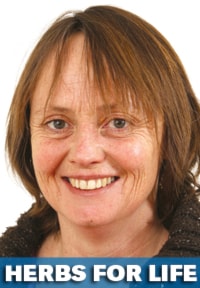This past weekend I raked the mulch off the gardens and was surprised to see several of my very delicate plant’s green leaves poking through the dark soil.
One of the good things about a very snowy winter that arrives before the ground has time to freeze is the snow insolates tender perennials. The extra snow covering increases their chances of greening up in the spring.
My first surprise was finding tiny lemon balm leaves shining like emeralds seeking the sun. If I only had 10 plants in my apothecary, lemon balm would be one of them. I am thrilled to see it has over-wintered. Lemon balm, as its name suggests, has a gentle lemon scent and a delicate lemony taste.
Dried lemon balm leaves find their way in to many teas that I formulate. Lemon balm soothes a restless mind, settles upset stomachs and calms an anxious heart. I favour this herb for those who struggle with anxiety that affects their digestion and triggers heart palpations.
I will harvest the lemon balms leaves in August, making it into a glycerite. Glycerites are alcohol-free liquid herbal preparations.
They are good medicine for children, pregnant women and anyone who wishes to avoid alcohol. Lemon balm makes a delicious glycerite that is difficult for anyone to dislike.
The lavender plants are also eager to grow this spring. I have over-wintered lavender before, but it always returns as a shadow of its former self and even as the previous year’s plant struggles to find a foot-hold in the garden, I bring in fresh lavender plants from the greenhouse.
Occasionally I sprinkle lavender flowers in a tea to bring beauty to the blend, but mostly I like to make dream pillows with lavender.
Dream pillows are small sachets of lavender and hops that slip under pillows or are placed in the corner of crib to help bring sleep.
Both hops (which has not yet made itself known in the garden, its corner is still covered in snow) and lavender are sleep herbs. Lavender’s perfume cools an irritated mind and quiets a restless body, while hops’ heady scent is hypnotic and sleep-inducing. I love the sachets because they are a very traditional form of herbal medicine that is mostly forgotten.
Some of my hardy plants that seem to never dive underground when winter’s cold and snow arrives are very perky and welcoming the sun.
Celandine, a member of the poppy family, does not even look like it has been through the winter. Celandine loves to snuggle up to my hawthorn tree. (Although my husband says it loves to snuggle up to anything. Being a poppy, it self seeds vigourously.)
While hawthorn makes medicine for the heart, celandine loves to help out the liver. Celandine has an awful bitter taste.
Generally bitter herbs are cleansing to the liver. This is true in celandine’s case. But celandine’s true gift is dissolving gallstones while promoting good flow of bile from the lover.
It is specific when gallstones go hand in hand with migraine headache. I also use celandine to shrink fibroids.
I recall one client who took celandine to successfully dissolve gallstones and was surprised when her warts disappear. Celandine is strongly anti-viral and a poultice of fresh leaves will kill off warts. I now know it can also be taken internally to eliminate those nasty little growths.
I have used up all my celandine medicine I made last fall. I hope sometime this week to make up another batch with the early spring leaves.
Motherwort also never seems to disappear underground.
Motherwort first appears as a cluster of green leaves that are gentle to the touch. Yet, over the next few months, motherwort will become a stately presence in the garden, dominating one full corner while wrestling for space with the raspberry bushes. Motherwort usually wins.
Motherwort is medicine for women in transition, helping women stand their ground during times of change while caring for their livers, hearts and minds.
I am excited to be back in the garden. This year, I am trying not to make big plans and to keep it simple. I wonder if there is a herb for that!
Herbs for Life is written by Abrah Arneson, a local clinical herbalist. It is intended for information purposes only. Readers with a specific medical problem should consult a doctor. For more information, visit www.abraherbalist.ca. Arneson can be reached www.abraherbs.com.
